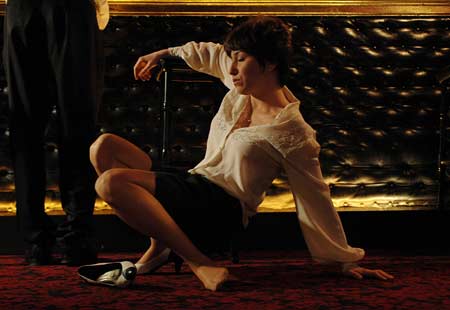Courses
Audiovisual production course May 2014
Production is the cornerstone of a project. To carry out an audiovisual project involves a difficulty and complexity that is often not seen at first glance. What are the main sources of financing for an audiovisual project? What exactly should an executive producer include in the dossier to present a project? What are the instruments of production? How to deal with the amortization plan?
This intensive production course will analyze all aspects related to this fundamental audiovisual discipline, without which it would be impossible for a project to get off the ground. From the embryonic phase of development and the importance of pre-production to the distribution and exploitation phase, a review will be made of all the key concepts to thoroughly understand the pillar on which any audiovisual production is based.
DURATION: 12 hours
TEACHER: Piluca Baquero
Piluca Baquero has been working in executive production for more than twenty years, and her credits include cult films such as Killer Barbies or Lo que sé de Lola. Founder of different production companies (Trastorno Films or Tráfico de ideas), Piluca Baquero combines her work in audiovisual production with teaching in different centers such as Camilo José Cela University.
Here you can see his IMDB profile
AIMED AT: producers, production assistants, production directors, directors, filmmakers and anyone who wants to understand how an audiovisual project is built.
PREVIOUS KNOWLEDGE: Basic knowledge of the audiovisual creation process.
PRICE: 200€ (170€ if the reservation is made before April 15th). You can get up to 20% discount if you sign up for several courses. Discounts are not cumulative.
WHEN: May 5 to 8, 2014. Afternoons from 17 to 20h (times may vary slightly).
WHERE: Campus Audiovisual Ces. See in Google Maps. If you need any kind of information you can contact 709 MR by email or phone (668826304).
COURSE CODE: PROD26-050514
CONTENTS:
Executive Production
1. EXECUTIVE PRODUCTION
1.1. WHAT IS PUBLIC COMMUNICATION?
1.2. WHAT IS A PRODUCTION COMPANY?
1.3. WHAT IS AN EXECUTIVE PRODUCER?
1.3.1.
Project development
1.3.2. Main technical team
1.3.3. Project image to proceed to its financing
1.4. FINANCING
1.4.1. Television
1.4.2. Internet rights
1.4.3. International public subsidies
1.4.7. Exploitation in cinemas
1.4.8. Exploitation in DVD or other formats
1.4.9. Product Placement
1.5. PRODUCTION
1.5.1. Post-production
1.5.2. Distribution and launching
1.5.3. Promotion
1.6. WHAT SHOULD AN EXECUTIVE PRODUCER INCLUDE IN THE
DOSSIER TO PRESENT A PROJECT?
1.6.1. Script
1.6.2. Production
1.6.3.
The script and cast,
Production tools
1. THE PEDAL CAR
2. THE SCRIPT: PRODUCTION TOOL
2.1. SEQUENCE
2.2. BREAKDOWN
2.3. SCENE
2.4. SYNOPSIS
2.5. TECHNICAL SPECIFICATIONS
2.6. ARTISTIC SPECIFICATIONS
2.7. PRODUCTION DATA
2.8. DIRECTOR’S NOTES
2.9. PRODUCTION NOTES
3. THE CAST: PRODUCTION TOOL
Financing
1. MAIN SOURCES OF FINANCING
Phases of a production
1. DEVELOPMENT
1.1. INTRODUCTION TO THE CONCEPT OF DEVELOPMENT
1.2. THE OBJECTIVES OF DEVELOPMENT IN A FILM PROJECT
1.3. THE DEVELOPMENT BUDGET
1.4. FINANCING THE DEVELOPMENT BUDGET
1.5. THE SCRIPT AS THE CENTRAL ELEMENT OF DEVELOPMENT.
EQUIPMENT AND BASIC CONCEPTS
1.5.1. The procurement of a script. Who? How?
1.5.2. The materials prior to the script
1.5.3. Script and its versions. The importance of the format
1.5.4. Basic concepts of dramaturgy
1.6. THE ELABORATION OF THE PACKAGE OR DOSSIER
1.6.1. The director
1.6.2. The actors
1.6.3. Technical crew list
1.6.4. Work or shooting plan
1.7. BUDGET
1.8. THE FINANCIAL PLAN
1.8.1. Grants
1.8.2. Pre-sales
1.8.3. Guaranteed Minimums
1.8.4. Capitalizations
1.8.5. Own Funds
1.8.6. Tax benefits
1.8.7. Repayable loans. Other investments
1.9. THE AMORTIZATION PLAN
1.10. THE CASH FLOW PLAN
2. PREPRODUCTION
2.1. PREPRODUCTION
2.1.1. Introduction to the concept of pre-production. Objectives
2.1.2.2. Objectives of the Preparation stage
2.1.2.1. The definition of the format, its artistic and technical importance
2.1.2.2. Locations
2.1.2.3. Shooting plan
2.1.2.3.1. Sets
2.1.2.3.2. The actors’ sessions
2.1.2.3.3. Collective bargaining agreement. Overtime
2.1.2.4. Final budget
2.1.2.4.1. Chapter 1: script and music
2.1.2.4.2. Chapter 2: artistic team
2.1.2.4.3. Chapter 3: technical team
2.1.2.4.4. Chapter 4: scenery
2.1.2.4.5. Chapter 5: shooting and miscellaneous production studios
2.1.2.4.6. Chapter 6: rolling machinery and transportation
2.1.2.4.7. Chapter 7: travel, hotels and meals
2.1.2.4.8. Chapter 8: virgin material
2.1.2.4.9. Chapter 9: laboratory
2.1.2.4.10. Chapter 10: insurance and social costs
2.1.2.4.11. Chapter 11: general expenses
2.1.2.4.12. Chapter 12: operating, commercial and financial expenses
2.1.2.5. The Budgetary Control or Cost Report and its periodicity
2.1.2.6. Cash Flow .
2.1.2.7. Casting
2.1.2.8. Hiring of equipment, suppliers, actors, etc.
2.1.2.9. Rehearsals with actors and technical tests
2.1.2.10. The incorporation schedule and general schedule
2.1.2.11. Script readings, technical script
3. SHOOTING
3.1. THE SHOOTING
3.1.1. Introduction to shooting. Basic definitions and objectives
3.1.2. The departments, their functions and scope.
Definitions and composition of each department
3.1.2.1. Direction
3.1.2.1.1.1. Director
3.1.2.1.2. First Assistant Director
3.1.2.1.1.3. Second assistants, shooting and “roles”
3.1.2.1.4. Script
3.1.2.1.5. Casting Director
3.1.2.2.2. Production
3.1.2.2.1. Production Manager
3.1.2.2.2.2. Production Manager
3.1.2.2.2.3. Production assistants, assistants and merit
3.1.2.2.4. Production Secretary
3.1.2.2.5. Accountant and/or Paying Cashier
3.1.2.3.3. Photography
3.1.2.3.1. The Director of Photography
3.1.2.3.2. The First Operator or cameraman
3.1.2.3.3. The Cinematographer
3.1.2.3.4. The Assistant cameraman
3.1.2.2.4. Art
3.1.2.4.1. The Art Director
3.1.2.4.2. The Assistant and his assistants
3.1.2.4.3. The props, some confusions
3.1.2.5. Costumes
3.1.2.6. Makeup and Hairstyling
3.1.2.7. Special Effects and Specialists
3.1.2.8. Sound
3.1.2.9. Editing
3.1.2.10. Electricians and Machinists
3.1.3. Reports and papers
3.1.3.1. The Agenda
3.1.3.2.
4. POST-PRODUCTION
4.1.
PHASES OF IMAGE POSTPRODUCTION
4.2. PHASES OF SOUND POSTPRODUCTION
4.3. POSTPRODUCTION
4.3.1. Introduction
4.3.2. The departments, their functions and scope
4.3.2.1.
The “off line” and “on line” concept
4.3.2.1.2. The laboratory, effects and color correction
4.3.2.1.3. The filming
4.3.2.2.2. The sound editing and music
4.3.2.2.2.1. The final mixes
4.3.2.2.3. Final processes and delivery
5. DISTRIBUTION AND OPERATION
5.1. DOMESTIC DISTRIBUTION AND OPERATION
5.2. INTERNATIONAL DISTRIBUTION
5.3. SALES TO TELEVISION STATIONS
You can download the documentation for the course here.
For more information and to reserve a place, please send an e-mail to info@709mediaroom.com.


